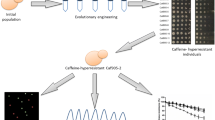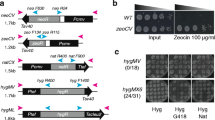Abstract
Caffeine is a base analogue and is known to affect a wide variety of cellular processes. In order to dissect genetically molecules which mediate the biological effects of caffeine, temperature-sensitive (ts) and caffeine-resistant mutants were isolated from fission yeast,Schizosaccharomyces pombe. Surprisingly, all twelve is isolates contained a mutation in the same locus,crm1. Cells of the iscrm1 mutant showed an abnormal chromosome structure at the restrictive temperature, an elevated expression of Pap1-dependent transcription, and cross-resistance to an unrelated drug such as staurosporine. Overproduction ofpap1 + also conferred caffeine resistance, whilst the resistance of thecrm1 mutant is abolished in thepap1 − background. These results show that thecrm1 + gene is a major locus for caffeine resistance, which arises from Pap1-dependent transcriptional activation.
Similar content being viewed by others
References
Adachi Y, Yanagida M (1989) Higher order chromosome structure is affected by cold-sensitive mutations in aSchizosaccharomyces pombe gene,crm1 +, which encodes a 115-kDa protein preferentially localized in the nucleus and its periphery. J Cell Biol 108:1195–1207
Balzi E, Goffeau A (1994) Genetics and biochemistry of yeast multidrug resistance. Biochem Biophys Acta 1187:152–162
Barbet NC, Muriel WJ, Carr AM (1992) Versatile shuttle vectors and genomic libraries for use withSchizosaccharomyces pombe. Gene 114:59–66
Beach D, Rodgers L, Gould J (1985)RAN1 + controls the transition from mitotic division to meiosis in fission yeast. Curr Genet 10:297–311
Benkö Z, Sipiczki M (1990) Caffeine resistance inSchizosaccharomyces pombe: a pleiotropic mutation affecting UV-sensitivity, fertility, and cell cycle. Curr Genet 18:47–52
Butcher RW, Sutherland EW (1962) Adenosine 3′,5′-phosphate in biological materials. J Biol Chem 237:1244–1250
Butgoyne RD, Cheek TR, Morgan A, O'Sullivan AJ, Moreton RB, Berridge MJ, Mata AM, Colyer J, Lee AG, East JM (1989) Distribution of two distinct Ca2+-ATPase-like proteins and their relationship to the agonist-sensitive calcium store in adrenal chromaffin cells. Nature 342:72–74
Costigan C, Gehrung S, Snyder M (1992) A synthetic lethal screen identifies SLK1, a novel protein kinase homolog implicated in yeast cell morphogenesis and cell growth. Mol Cell Biol 12:1162–1178
Devary Y, Gottlieb RA, Lau LF, Karin M (1991) Rapid and preferential activation of the c-jun gene during the mammalian UV response. Mol Cell Biol 11:2804–2811
DeVolti J, Seydoux G, Beach D, McLeod M (1991) Interaction betweenran1 + protein kinase and cAMP-dependent protein kinase as negative regulators of fission yeast meiosis. 10:3759–3768
Downes CS, Clarke DJ, Mullinger AM, Gimenez-Abian JF, Creighton AM, Johnson RT (1994) A topoisomerase II-dependent G2 cycle checkpoint in mammalian cells. Nature 372:467–470
Gounalaki N, Thireos G (1994) Yap1p, a yeast transcription activator that mediates multidrug resistance, regulates the metabolic stress response. EMBO J 13:4036–4041
Gutz H, Heslot H, Leupold U, Loprieno N (1974)Schizosaccharomyces pombe. In: King RC (ed) Handbook of genetics. Plenum Press, New York, pp 395–466
Hattori M, Sakaki T (1986) Dideoxy sequencing method using denatured plasmid templates. Anal Biochem 152:232–238
Hertle K, Haase E, Brendel M (1991) TheSNQ3 gene ofSaccharomyces cerevisiae confers hyper-resistance to several functionally unrelated chemicals. Curr Genet 21:319–324
Higgins CF (1992) ABC transporters: from microorganisms to man. Annu Rev Cell Biol 8:67–113
Hirano T, Kinoshita N, Morikawa K, Yanagida M (1990) Snap helix with knob and hole: essential repeats inS. pombe nuclear proteinnuc2 +. Cell 60:319–328
Hirata D, Yano K, Miyakawa T (1994) Stress-induced transcriptional activation mediated byYAP1 andYAP2 genes that encode the Jun family of transcriptional activators inSaccharomyces cerevisiae. Mol Gen Genet 242:250–256
Ito H, Fukuda Y, Murata K, Kimura A (1983) Transformation of intact yeast cells treated with alkali cations. J Bacteriol 153:163–168
Kihlman BA (1977) Caffeine and chromosomes. Elsevier, Amsterdam
Kuge S, Jones N (1994) YAP1-dependent activation ofTRX2 is essential for the response ofSaccharomyces cerevisiae to oxidative stress by hydroperoxides. EMBO J 13:655–664
Laemmli UK (1970) Cleavage of structural proteins during the assembly of the head bacteriophage T4 Nature 227:680–685
Lai MH, Bard M, Pierson CA, Alexander JF, Goebl M, Carter G, Kirsh DR (1994) Identification of a gene family in theSaccharomyces cerevisiae ergosterol biosynthesis pathway via selection for clones producing morpholine resistance. Gene 140:41–49
Lehmann IR, Kirk-Bell S, Arlett CF, Paterson MC, Lohman PHM, de Weerd-Kastelein EA, Bootsma D (1975) Xeroderma pigmentosum cells with normal levels of excision repair have a defect in DNA synthesis after UV irradiation. Proc Natl Acad Sci USA 72:219–223
Leppert G, McDevitt R, Falco SC, Van Dyk TK, Ficke MB, Goli J (1990) Cloning by gene amplification of two loci conferring multidrug resistance inSaccharomyces. Genetics 125:13–20
Loprieno N, Schüpbach M (1971) On the effect of caffeine on mutation and recombination inSchizosaccharomyces pombe. Mol Gen Genet 110:348–354
Livingstone C, Patel G, Jones N (1995) ATF2 contains a phosphorylation-dependent transcriptional activation domain. EMBO J 14:1785–1797
Marger MD, Saier MH Jr. (1993) A major superfamily of transmembrane facilitators that catalyse import, symport and antiport. Trends Biochem Sci 18:13–20
Meyer M, Schreck R, Baeuerle P (1993) H2O2 and antioxidants have opposite effects on activation of NF-κB and AP-1 in intact cells: AP-1 as secondary antioxidant-responsive factor. EMBO J 12:2005–2015
Moffat GJ, McLaren AW, Wolf CR (1994) Involvement of Jun and Fos proteins in regulating transcriptional activation of the human π class glutathioneS-transferase gene in multidrug-resistant MCF7 breast cancer cells. J Biol Chem 269:16397–16402
Moreno S, Klar A, Nurse P (1991) Molecular genetic analysis of fission yeastSchizosaccharomyces pombe. Methods Enzymol 194:795–823
Moye-Rowley WS, Harshman KD, Parker CS (1989) YeastYAP1 encodes a novel form of the jun family of transcription activator proteins. Genes Dev 3:283–292
Nishi K, Yoshida M, Nishikawa M, Nishiyama M, Horinouchi S, Beppu T (1992) A leptomycin B resistance gene ofSchizosaccharomyces pombe encodes a protein similar to the mammalian P-glycoproteins. Mol Microbiol 6:761–769
Nishi K, Yoshida M, Fujiwara D, Nishikawa M, Horinouchi S, Beppu T (1994) Leptomycin B targets a regulatory cascade of crm1, a fission yeast nuclear protein, involved in control of higher order chromosome structure and gene expression. J Biol Chem 269:6320–6324
Nojima H, Leem S-H, Araki H, Sakai A, Nakashima N, Kanaoka Y, Ono Y (1994) Hac1: a novel yeast bZIP protein binding to the CRE motif is a multicopy suppressor ofcdc10 mutants ofSchizosaccharomyces pombe. Nucleic Acids Res 22:5279–5288
Ohkura H, Adachi Y, Kinoshita N, Niwa O, Toda T, Yanagida M (1988) Cold-sensitive and caffeine-supersensitive mutants of theSchizosaccharomyces pombe dis genes implicated in sister chromatid separation during mitosis. EMBO J 7:1466–1473
Sambrook J, Fritsch EF, Maniatis T (1989) Molecular cloning: a laboratory manual (2nd edn) Cold Spring Harbor Laboratory Press, Cold Spring Harbor, New York
Sanger F, Nicklen S, Coulson AR (1977) DNA sequencing with chain-terminating inhibitors. Proc Natl Acad Sci USA 74:5463–5467
Schlegel R, Pardee AB (1986) Caffeine-induced uncoupling of mitosis from the completion of DNA replication in mammalian cells. Science 232:1264–1266
Schlegel R, Pardee AB (1987) Periodic mitotic events induced in the absence of DNA replication. Proc Natl Acad Sci USA 84:9025–9029
Schlegel R, Croy RG, Pardee AB (1987) Exposure of caffeine and suppression of DNA replication combine to stabilize the proteins and RNA required for premature mitotic events. J Cell Physiol 131:85–91
Schnell N, Krems B, Entian K-D (1992) ThePAR1 (YAP1/SNQ3) gene ofSaccharomyces cerevisiae, a c-jun homologue, is involved in oxygen metabolism. Curr Genet 21:269–273
Shimanuki M, Goebl M, Yanagida M, Toda T (1992) Fission yeaststs1 + gene encodes a protein similar to the chicken lamin B receptor and is implicated in pleiotropic drug-sensitivity, divalent cation-sensitivity, and osmoregulation. Mol Biol Cell 3:263–273
Shimanuki M, Saka Y, Yanagida M, Toda T (1995) A novel essential fission yeast gene,pad1 +, positively regulatespap1 +-dependent-dependent transcription and is implicated in the maintenance of chromosome structure. J Cell Sci 108:569–579
Sutton A, Immanuel D, Arndt K (1991) The SIT4 protein phosphatase functions in late G1 for progression into S phase. Mol Cell Biol 11:2133–2148
Tamaoki T, Nomoto H, Takahashi I, Kato Y, Morimoto M, Tomita F (1986) Staurosporine, a potent inhibitor of phospholipid/Ca++-dependent protein kinase. Biochem Biophys Res Commun 135:397–402
Toda T, Yamamoto M, Yanagida M (1981) Sequential alteration in the nuclear chromatin region during mitosis of the fission yeast Schizosaccharomyces pombe: video fluorescence microscopy of synchronously growing wild-type and cold-sensitive cdc mutants by using a DNA-binding fluorescent probe. J Cell Sci 52:917–925
Toda T, Shimanuki M, Yanagida M (1991) Fission yeast genes that confer resistance to staurosporine encode an AP-1-like transcription factor and a protein kinase related to the mammalian ERK1/MAP2 and budding yeastFUS3 andKSS1 kinases. Genes Dev 5:60–73
Toda T, Shimanuki M, Saka Y, Yamano H, Adachi Y, Shirakawa M, Kyogoku Y, Yanagida M (1992) Fission yeast pap1-dependent transcription is negatively regulated by an essential nuclear-protein, crm1. Mol Cell Biol 12:5474–5484
Toda T, Shimanuki M, Yanagida, M. (1993) Two novel protein kinase C-related genes of fission yeast are essential for cell viability and implicated in cell shape control. EMBO J 12:1987–1995
Towbin H, Staehelin T, Gordon J (1979) Electrophoretic transfer of proteins from polyacrylamide gels to nitrocellulose sheets: a procedure and some applications. Proc Natl Acad Sci USA 76:4350–4354
Turi TG, Webster P, Rose JK (1994) Brefeldin A sensitivity and resistance inSchizosaccharomyces pombe. J Biol Chem 269:24229–24236
Yoshida M, Nishikawa M, Nishi K, Abe K, Horinouchi S, Beppu T (1990) Effects of leptomycin B on the cell cycle of fibroblasts and fission yeast cells. Exp Cell Res 187:150–156
Author information
Authors and Affiliations
Additional information
Communicated by M. Sekiguchi
Rights and permissions
About this article
Cite this article
Kumada, K., Yanagida, M. & Toda, T. Caffeine-resistance in fission yeast is caused by mutations in a single essential gene,crm1 + . Molec. Gen. Genet. 250, 59–68 (1996). https://doi.org/10.1007/BF02191825
Received:
Accepted:
Issue Date:
DOI: https://doi.org/10.1007/BF02191825




